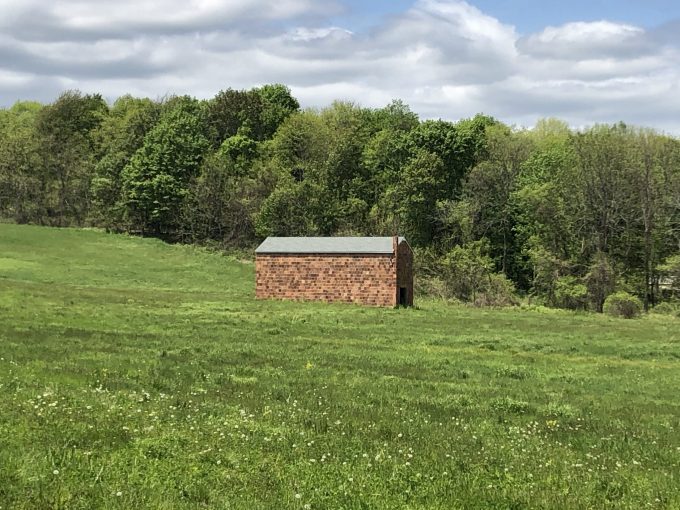Only Remaining Hollow Tile Mushroom Barn in…
Auer Farm Mushroom Barn, Bloomfield
I know you historic mushroom barn fans wouldn’t let me get away with not including this on CTMQ. I’m happy to not have let you down. There’s a lot going on with this humble little building everyone sees on route 185 driving into Hartford from Simsbury and Granby every day.

Surely everyone waiting for that stoplight to change lets their eyes wander across the sweeping hill of Auer Farm to the lonely building, seemingly plopped down in the middle of nowhere. (It is about as far from all the Auer Farm buildings as possible.)
And now, next time you are in that position, you’ll have something to think about! This could be the last hollow tile mushroom barn left in New England, if not in all of America! Some people say that this is the last remaining hollow tile mushroom barn in existence in the world!
The barn had fallen into disrepair and a nor’easter ripped its roof off at some point around 2014 or so. It was doomed. That’s when preservationists stepped in, recognizing the historical important of the place. In fact, when the effort got underway, big plans were envisioned for the barn.

Getting a new roof in 2016.
Jack Hasegawa, Executive Director of the 4-H Education Center at Auerfarm said, “Because of its location, it will serve as an ideal visitor and information center, farm museum and store and, perhaps, a weekly Farmers’ Co-op market place.”
Wait. It’s location is not ideal for any of that, other than, perhaps (please?!) a tiny farm museum. (The closest parking is a good 10 minute walk across an open tick-infested field away.)
Constructed in 1919 – wait. It’s only a hundred years old? Hurrumph. It was used until 1946 to grow mushrooms on a commercial scale. I’m thinking about the town of Franklin and how that huge mushroom growing company was there and what they’d think of this being “at commercial scale.” Anyway, the building and land was purchased in 1946 by the Auerbach family and used for apple and cider production until 1976. The unusual shape and material was recommended as early as 1891 as conducive to cultivating mushrooms as it was fire resistant, required no maintenance, and its insulating properties reduced air and moisture infiltration.
Yes, that Auerbach family. (One of the most random things on this website, besides this very page, is my visit to Beatrice Auerbach’s house.)
Fundraisers were held to replace the roof and I’m pleased to report they were successful! The structure was shored up and the interior cleaned up. I’ll keep an eye on the place if it ever becomes a farm museum. Or an actual mushroom barn.

![]()
Auer Farm
CTMQ’s All Things Auer Farm
CTMQ’s Firsts, Onlies, Oldests, Largests, Longests, Mosts, Smallests, & Bests

Leave a Reply